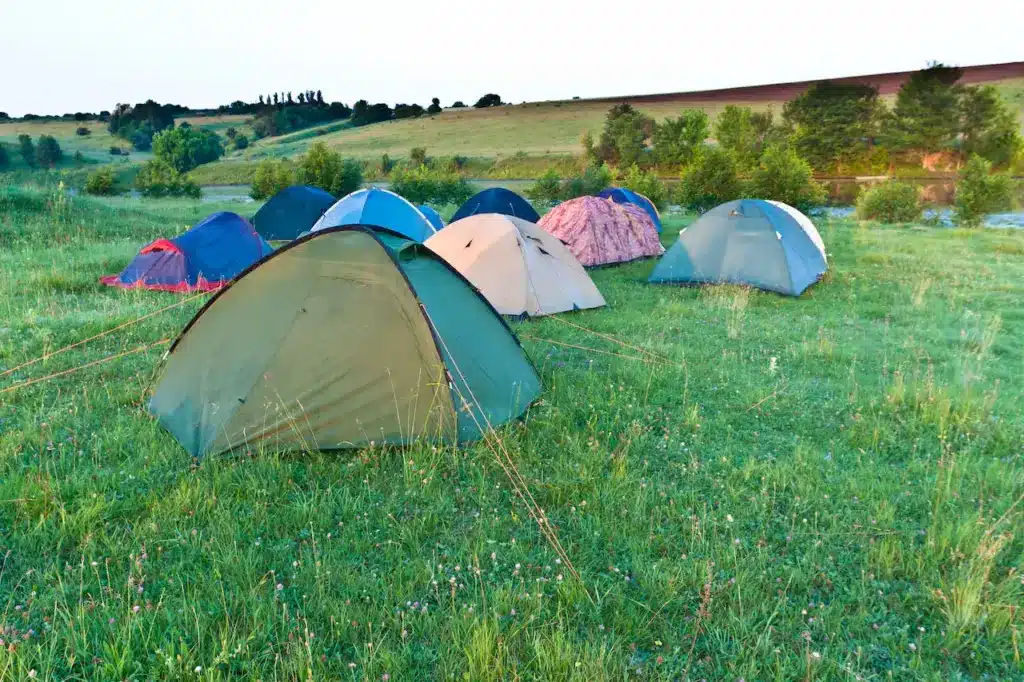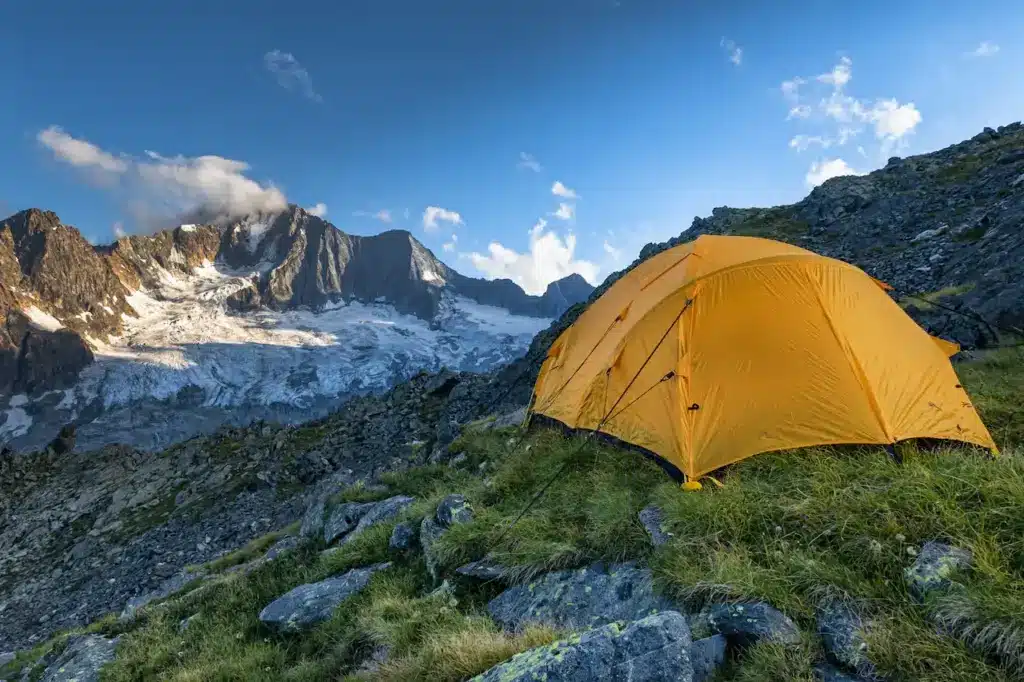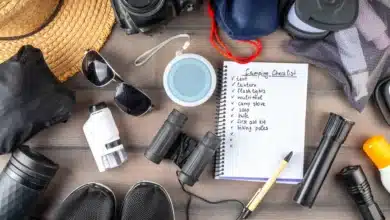When you’re hiking, having the ability to quickly set up a tent and settle in for the night wherever you may be is very freeing. But to fully enjoy this freedom, having the right tent is crucial – one that’s lightweight, easy to set up, and can handle the conditions. With so many options available, picking the best tent for your needs can be challenging.
When choosing a tent, prioritize lightweight materials like nylon or polyester to keep the packed weight under 2-3 lbs. Dome styles offer good wind resistance for exposed hikes. Look for durable, waterproof fabric with sealed seams to stay dry in the rain.
Ventilation features like mesh panels reduce condensation. Freestanding tents with quick hub-and-pole setups make pitching fast and easy.

Accessory features like gear lofts, pockets, and vestibules add convenience without too much weight. For solo trips, 1-person tents suffice, but 2-person tents allow sharing the load with a partner.
Before buying, make sure to compare weight, packed size, weather protection, and key features among top brands. With a bit of research, finding a high-quality yet budget-friendly lightweight backpacking tent is achievable.
In this guide, we’ll discuss the key factors to think about when selecting a lightweight hiking tent so you can find the ideal portable shelter.
How To Choose The Best Lightweight Tent for Hiking
When you’re planning a hiking trip, choosing the right tent is crucial. You need a tent that’s lightweight and compact so it doesn’t burden you on the trail, yet offers the space, weather protection, and features to meet your needs.
With so many options on the market, picking the best lightweight hiking tent requires some careful consideration.
Focus on Low Weight
The weight of your tent is one of the most important factors for hiking and backpacking. You’ll be carrying the tent on your back for miles, so you want it to be as light as possible. Most quality lightweight hiking tents weigh around 1-2 kg. Tents over 2 kg start to get heavy and can weigh you down on long hikes.
When comparing tent weights, look at the total weight, including the tent body, rainfly, poles, stakes, and any other components. The most compact hiking tents pack down small, so they’re easier to fit in your backpack as well.
Pick The Right Capacity
Consider how much space you need when choosing tent size and capacity. For solo hikers, a 1-person tent keeps weight low. If hiking often with a partner, a 2-person tent allows sharing the load. Larger 3-4-person tents can work for family car camping but are heavy for backpacking.
Many hiking tents fold down into a small carry bag that attaches to a backpack, much like a sleeping bag. But with more capacity comes more bulk, so lightweight 1-2 person tents are best for backpackers covering long distances.
Assess Season Ratings
Look at the season rating of any tent you’re considering. 3-season tents handle milder spring, summer, and fall conditions. For winter camping or extreme weather, 4-season tents are more durable.
Make sure the tent you choose has a waterproof rainfly, sealed seams to prevent leaks, and enough tie-down points to withstand wind gusts. Dome-style tents tend to be sturdier in high winds. For hot weather, mesh panels improve ventilation and airflow.
Premium Materials For Durability
Most lightweight hiking tents use nylon or polyester fabric. Nylon is lightweight and stretchy but can be damaged by UV exposure. Polyester is tougher but less breathable. For ultralight tents, advanced materials like Dyneema Composite Fabric maximize strength at very low weights.
No matter the material, inspect workmanship closely. Look for high-quality components, sealed seam construction, and reinforced stress points for improved weather protection and longevity. Rugged zippers also prevent breakage. Be sure to choose level tent sites and avoid sharp objects to prevent rips and tears.
Useful Features To Consider
When comparing tent options, look for features that make camping more convenient:
- Vestibules provide protected storage space for gear
- Interior organizational pockets and loops
- Full-coverage waterproof rain fly with guy lines
- Mesh canopy for stargazing on clear nights
- Dual doors and windows improve ventilation
- Quick hub-and-pole system enables easy setup
- Pop-up pole design allows instant one-step setup
For new campers, simple pop-up tent styles are set up quickly in just a minute. More advanced freestanding tents allow flexible positioning on varied terrain.
Choosing the ideal hiking tent requires balancing weight, capacity, weather protection, and useful extras. Do some research to find a reputable lightweight backpacking tent that fits your needs so you can enjoy the freedom of pitching your perfect portable shelter anywhere your hiking adventures take you.

Clostnature Ultralight Hiking Tent
This ultralight one-person tent from Clostnature is one of the most compact options when folded down, weighing only 1.7kg to make it easy to carry. The polyester tent is designed for all seasons and has a high waterproof rating thanks to the PU 5000 coating on the fabric.
Some key features include a large vestibule area to store luggage and shoes while keeping them protected, well-sealed seams that prevent water from leaking in, aircraft-grade aluminium poles that provide stability even in windy conditions, a ventilation window, and two-way zippers to improve airflow and prevent condensation buildup.
The spacious vestibule allows quick access to gear, while the durable, waterproof, and windproof construction stands up to the elements. However, the limited space is really only suitable for one person, and condensation can still build up at night.
Pros
- Extremely lightweight and compact when packed
- Durable, waterproof, and windproof construction
- Spacious vestibule for gear storage
- Quick and easy setup with color-coded poles
Cons
- Limited space for more than one person
- Condensation can still build up at night
Naturehike Cloud Up Lightweight Hiking Tent
This lightweight 1-person tent from Naturehike is one of the most portable options, weighing only 1.5kg. With windows at both ends for superior ventilation, it helps reduce condensation compared to other lightweight tents.
The nylon construction makes it waterproof, windproof, and anti-snow, suitable for 3-season backpacking trips. When folded down, it packs to just 41cm x 13cm.
Some other useful features include a vestibule for storing shoes and gear, wind ropes for stability in gusty conditions, availability in a variety of colour options, and a freestanding design that allows flexible setup virtually anywhere.
The excellent ventilation and weatherproof 3-season performance make it ideal for backpacking, while the compact packed size doesn’t take up much room. However, the vestibule space is somewhat limited for bulky gear.
Pros
- Excellent ventilation from dual windows
- Compact and ultralight for backpacking
- Weatherproof 3-season performance
- Easy setup with colour-coded poles
Cons
- Vestibule space is somewhat limited
BISINNA Lightweight 2-Person Hiking Tent
This durable polyester tent from BISINNA provides a roomy and lightweight shelter for 2 people weighing 2.1kg. With a 2000mm waterproof rating, it stands up to wet weather and includes aluminium poles and guy lines for wind resistance.
Some useful features include large flysheet extensions on both sides for protected gear storage, a freestanding design for flexible pitching in varied terrain, two mesh screens that enhance ventilation, and a quick solo setup time of about 10 minutes.
There is ample interior space with enough headroom for two occupants, and the tent performs well in wind and rain. However, some loose stitching is apparent in places, and the weight is heavier than some 1-person backpacking tents.
Pros
- Spacious interior with ample headroom
- Waterproof and stable in wind/rain
- Extended flysheet for equipment storage
- Quick solo setup in just 10 minutes
Cons
- Some loose stitching in places
- Heavier than some 1-person tents
Stansport Scout Lightweight 2-Person Tent
This affordable nylon backpacking tent from Stansport has an attractive A-frame design and packs down small, weighing just 1.5kg. The simple setup takes one person about 10 minutes.
However, it lacks durability compared to more expensive options; the thin material is prone to tearing, and a rain tarp or fly is recommended in wet weather.
On the plus side, the compact, lightweight design is easy to carry backpacking, and the quick, simple setup is beginner-friendly. While it may not stand up to extreme weather, the low cost makes it a budget-friendly choice.
Pros
- Lightweight and packs down small
- Quick and simple setup
- Inexpensive price point
Cons
- Thin material prone to tearing
- Not ideal for heavy rain
Hillman 2-Person Dome Tent

This dome-style tent provides a lightweight shelter for 2 people at 2.3kg. Large mesh sections enhance airflow and ventilation.
Some other useful features include double-stitched sealed seams to prevent leaks, coated polyester fabric that offers water resistance, a free-standing design that enables flexible setup in varied terrain, and a roomy interior with ample head clearance.
However, the floor is quite thin and may be prone to damage, so this tent is best suited for mild weather, not extreme rain or wind. The exact waterproof rating is also unclear.
While the ample mesh improves ventilation and the seams prevent leaks, the tent is not as durable or weatherproof as some higher-end models and is a bit heavy for extended backpacking trips.
Pros
- Good ventilation from ample mesh
- Double-stitched seams prevent leaks
- Spacious interior with room to move
- Relatively easy setup
Cons
- The floor is thin and less durable
- Not ideal for very wet conditions
- Heavier than some backpacking tents
Narmay Snakeskin Lightweight Dome Tent
This 2-person dome tent from Narmay has an attractive snakeskin-patterned design and weighs 2kg, making it a fairly lightweight option. The polyester fabric is UV-resistant, and the mesh inner tent improves airflow and ventilation on hot days.
It includes all the components needed to secure the tent in windy conditions, with guy lines and sturdy pegs. The waterproof rating also makes it suitable for wet weather camping. The interior offers enough room for 2 people and may work for 3 smaller occupants.
However, when packed into the carry bag, it is bulkier than some backpacking tents. Refolding the tent neatly can also be tricky after taking it down.
Pros
- Unique and stylish snakeskin design
- Good ventilation from mesh inner tent
- Includes equipment to secure in windy conditions
- Waterproof and weatherproof
Cons
- Bulky packed size for backpacking
- It can be difficult to refold neatly
Teton Sports Quick 1-Person Tent
This instant pop-up tent from Teton Sports sets up in under 1 minute thanks to fixed, lockable poles. Weighing 2.3kg, it provides a roomy shelter for 1 person.
The taffeta tent includes a waterproof rain fly and a mesh inner tent that can be opened for stargazing. Other features include two-way zippers and a gear loft for storing essentials.
While the nearly instant setup is exceptionally easy, the packed weight is heavy for backpacking compared to other 1-person tents. The rain fly also lacks guy lines to secure it in windy conditions. But for fast, fuss-free camping, it’s a convenient choice.
Pros
- Ultra-fast 60-second setup
- Waterproof rainfly included
- Spacious interior for 1 person
- Mesh inner tent for stargazing
Cons
- Relatively heavy packed weight
- Rainfly lacks guy lines
Night Cat 2-Person Lightweight Tent
This easy-to-pitch tent provides a budget-friendly shelter for 2 people at 2kg. The fibreglass and polyurethane fabric offers a PU 3000mm waterproof rating.
The simple design has one access point and handy interior storage pockets. Setting up the tent, fly, and guy lines is straightforward. Packing it up is also easy, with a foldable design and carry bag.
While suitable for most conditions, it may struggle in extreme weather. Overall, it’s an affordable and uncomplicated tent for 2 people looking for an easy camping experience.
Pros
- Budget-friendly price
- Quick and simple setup
- Packs away easily into the carry bag
- Decent PU 3000 waterproof rating
Cons
- Not ideal for harsh weather
Geertop Portable Lightweight 1-Person Tent
This lightweight 1-person tent from Geertop weighs just 1.5kg, making it highly portable for backpacking. The polyester tent features full mesh interior walls that allow it to open up completely for superior ventilation on hot days.
It has a 5000mm waterproof rating thanks to the full coverage fly that extends over the entire tent. Useful features include interior pockets to keep gear organized, as well as two vestibules to store shoes and packs.
Pros
- Excellent airflow from full mesh design
- Complete rain fly coverage for weather protection
- Interior pocket and vestibules for gear storage
Cons
- Lower-quality carry bag
- Floor durability could be improved
ALPS Mountaineering Lynx 1-Person Tent

The ALPS Mountaineering Lynx is a freestanding lightweight backpacking tent that weighs just 1.8kg. At over 7 feet long, it provides ample room for one person. The polyester tent is designed for 3-season use.
The UV-resistant fly extends out to create a vestibule for keeping gear dry. Factory-sealed seams and a 2000mm floor coating improve weather resistance. Inside are a side pocket and overhead mesh storage. Half mesh walls allow ventilation.
This high-quality tent offers easy setup thanks to the freestanding design. The competitive price makes it a top choice for budget-conscious hikers.
Pros
- Lightweight at 1.8kg for one person
- Freestanding setup doesn’t require pegs
- Spacious vestibule area
- Two handy interior storage pockets
Cons
- Narrow width is not ideal for larger campers
Conclusion
Finding the right lightweight hiking tent is a key part of preparing for backpacking adventures. With so many options on the market, it can be tricky to determine which tent will best meet your needs on the trail. By carefully considering a few key factors, you can zero in on a tent that balances weight, space, durability, and useful features.
When choosing a lightweight backpacking tent, weight should be one of the top priorities. Look for tents made with ultra-lightweight fabrics like nylon or polyester that keep the packed weight under 2-3 lbs.
This ensures you don’t lug unnecessary pounds mile after mile on the hiking trail. Space is also important – 1-2 person tents are best for keeping weight down while still allowing room to sleep and store a bit of gear.
You’ll also want to assess the weather protection offered by the tent. 3-season tents work for most conditions, but 4-season tents are more versatile for extreme weather. Look for waterproof construction with sealed seams, sturdy pole systems, and good ventilation from mesh panels. And consider useful extras like interior pockets, vestibules, and easy hub-and-pole setup.
Taking the time to find the right balance of weight, space, weather protection, durability, and extra features means you’ll have the perfect tent for enjoying the freedom of pitching your own shelter on hiking and backpacking adventures for years to come.



